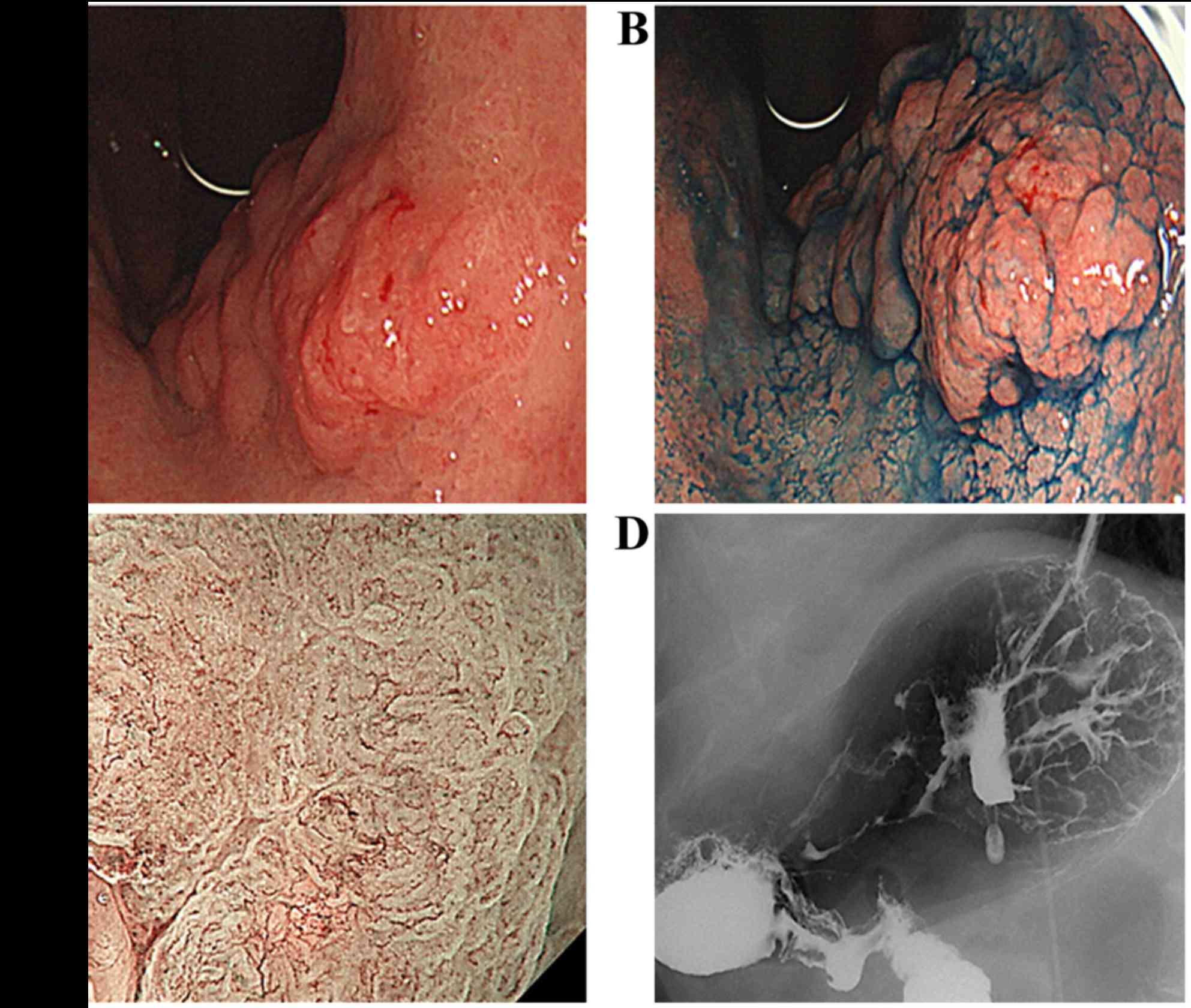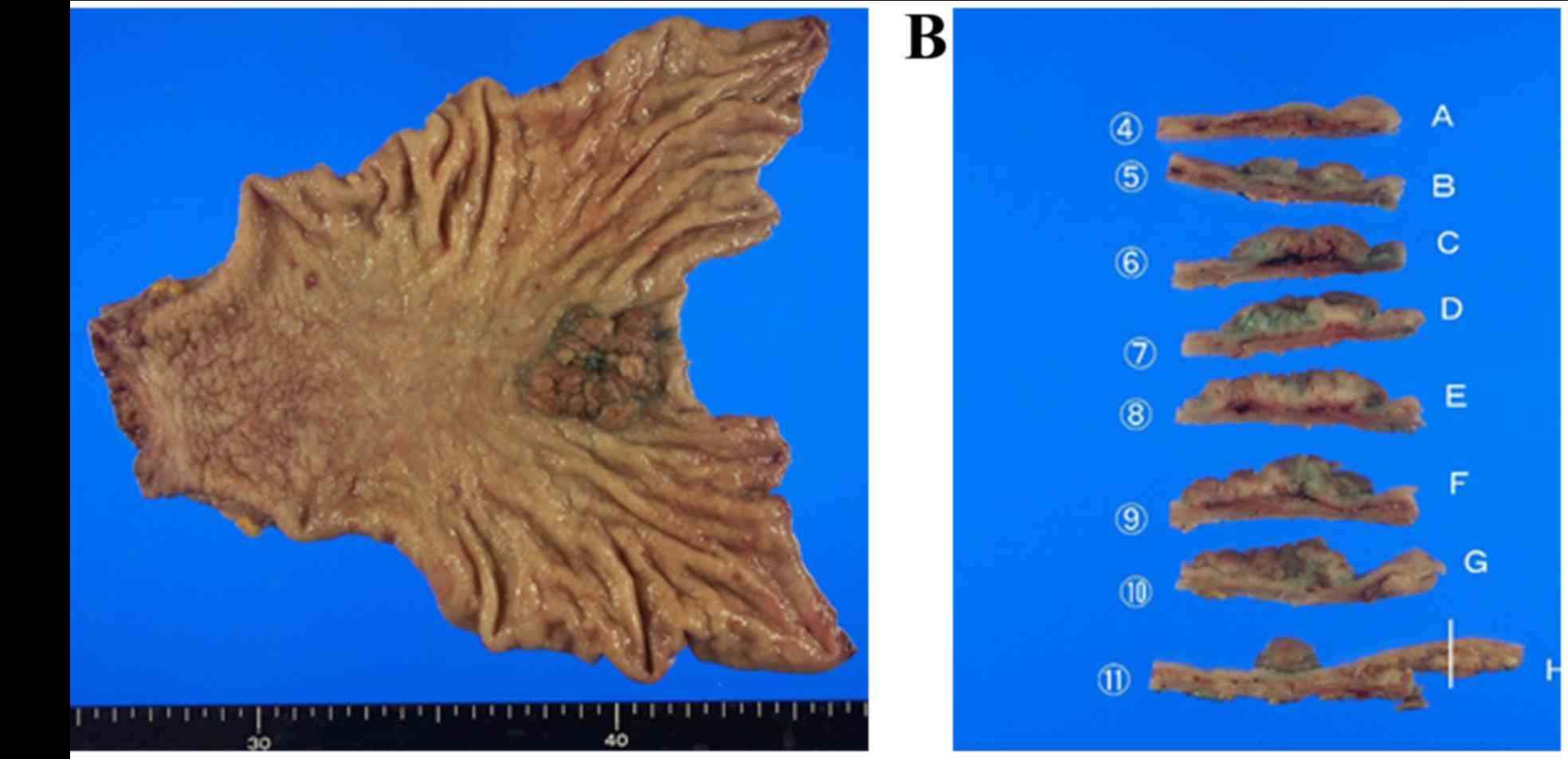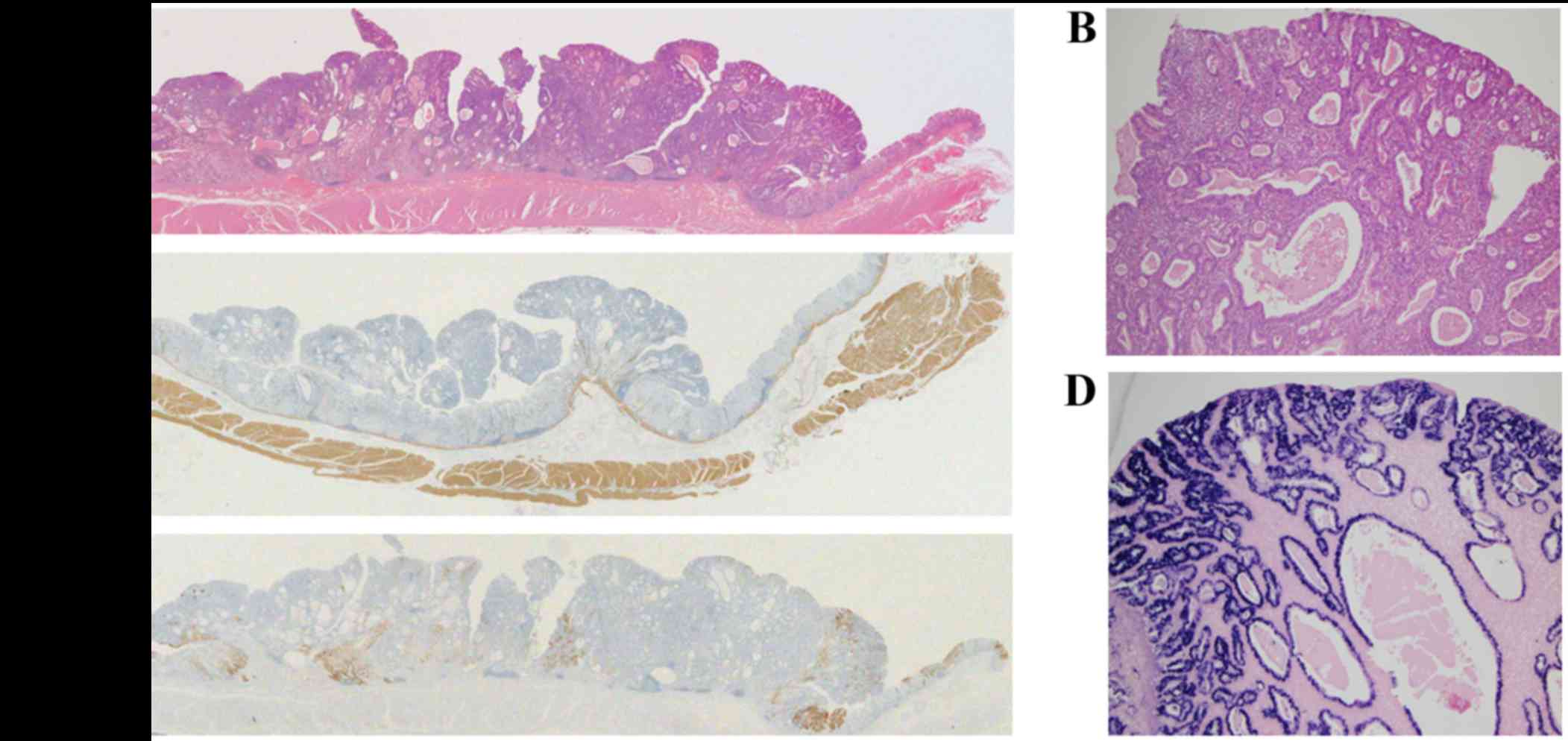Unusual growth of an Epstein-Barr virus-associated differentiated early-stage gastric carcinoma: A case report
- Authors:
- Published online on: March 5, 2018 https://doi.org/10.3892/mco.2018.1586
- Pages: 657-660
Abstract
Introduction
Epstein-Barr virus (EBV)-associated gastric carcinoma (GC) is defined by the presence of EBV within tumor cells (1–3). Clonal EBV is present in ~10% of GCs and is associated with distinct clinicopathological features. The typical characteristics of EBV-positive GC are male predominance, upper- and middle-third anatomical location, poorly differentiated carcinoma with dense infiltration of lymphocytes (1–3), and lymph node metastasis is rare in the EBV-positive than in EBV-negative GC. (4). On endoscopy, the informative features have been suggested to be superficial, depressed, ulcerated (5) or ‘saucer-like’ tumor appearance, accompanied by submucosal nodules of carcinoma with lymphoid stroma (1).
The present study reports a case of unusual growth of EBV-associated early-stage GC, which exhibited a polypoid form and appeared to be differentiated on histopathology. In addition, the clinicopathological features of 25 EBV-associated GCs from 20 patients treated in our hospital between 2005 and 2014 were reviewed for comparison with the current case.
Fujita Health University School of Medicine approved the study protocol, and written informed consent was obtained from all participants.
Case report
In June 2014, A 72-year-old male was receiving treatment for a cerebral infarction in the left medulla oblongata in the Fujita Health University Hospital. He underwent esophagogastroduodenoscopy (EGD) due to suspicion of gastrointestinal bleeding following the appearance of blood in the nasogastric tube aspirate. Physical examination revealed left hemiparesis. Laboratory evaluation did not show any abnormal findings, including red blood cell count and levels of hemoglobin, hematocrit and tumor markers (carcinoembryonic antigen and carbohydrate antigen 19-9).
EGD revealed an uneven, type 0–I protruding lesion measuring ~4.0 cm, which was located in the lesser curvature of the upper gastric corpus (Fig. 1A and B). Magnifying endoscopy with narrow-band imaging revealed irregular microvascular and microsurface patterns with clear demarcation, suggesting that the lesion was a carcinoma (Fig. 1C). Double-contrast upper gastrointestinal barium X-ray radiography also showed an uneven, type 0–I protruding lesion in the same location in the stomach, consistent with the EGD findings (Fig. 1D).
Biopsy specimens taken from the protruding lesion during EGD indicated a well-differentiated adenocarcinoma. Although no distant or lymph node metastases were observed on computed tomography, submucosal invasion was suspected due to the marked thickness, uneven form, and 4-cm diameter of the tumor. Based on its macroscopic appearance, laparoscopic gastrectomy with D1 lymphadenectomy was performed.
The resected tumor was 3.8×3.5×1.0 cm in size within the resected surgical specimen. The tumor had an elastic consistency, and its surface was uneven and irregular (Fig. 2A). The specimen was then cut into 11 pieces for histological assessment (Fig. 2B).
Histological assessment using the hematoxylin and eosin staining revealed polypoid growth of a well-differentiated tubular or papillary adenocarcinoma, with dense infiltration of lymphocytes through the entire layer of the tumor (Fig. 3A and B). Marked cystic dilatation and rounded expansion of the malignant glands with rich vascularization was also observed (Fig. 3B). The tumor cells were localized within the mucosal layer of the stomach, and an absence of submucosal invasion was confirmed using desmin immunohistochemistry (Fig. 3C). The carcinoma crypts, but not the infiltrating lymphocytes were EBV-positive on in situ hybridization (Fig. 3D). Immunohistochemistry also revealed that the tumor cells were partially positive for mucin (MUC) 5AC (Fig. 3E), but not for MUC6 or MUC1 (data not shown). No lymph node metastasis was observed in the resected lymph nodes.
Discussion
EBV-positive GCs are characterized by distinctive clinicopathological features (1–4). TP53 mutations are rare in the EBV-positive than in EBV-negative GC (1). The typical endoscopic findings of EBV-associated GC are reported to be superficial, depressed, ulcerated (5) or ‘saucer-like’ (surrounding elevation) appearance of the tumor (1). When reviewing the clinicopathological features of 25 EBV-associated GCs from 20 patients treated in our hospital between 2005 and 2014 (Table I), all tumors except that in the current case appeared as shallow, depressed lesions (0–IIc, 0–IIc+III or 0–IIa+IIc) in the early stages and as ulcerative lesions (type 2 or type 3) in the advanced stages, according to the Japanese classification (6). Therefore, the current case, which showed polypoid growth of a well-differentiated tubular or papillary adenocarcinoma, with dense infiltration of lymphocytes through the entire layer of the tumor, seemed to be an unusual morphological appearance.
Table I.Clinicopathological features of 25 Epstein-Barr virus-associated gastric cancers from 20 patients. |
The reasons underlying the unusual morphological appearance of the present case of EBV-associated GC are not clear. The background gastric mucosa in this case showed severe gastric atrophy, suggesting severe hypochlorhydria. Such a pathological state of the gastric mucosa may be associated with polypoid growth of well-differentiated tubular or papillary adenocarcinoma, even if it is EBV-associated. The typical histological features of EBV-associated GC include poorly differentiated carcinoma with dense infiltration of lymphocytes (1–3), while well or moderately differentiated histopathology may also be observed (1).
In the cases reviewed from our hospital, 5 out of 6 superficial cancers (M or SM1), including the current case, exhibited a differentiated histological type (well or moderately differentiated adenocarcinoma), suggesting that a considerable portion of the EBV-associated cases may have originally developed with a differentiated histopathology and then become poorly differentiated in the more advanced stages.
Dense infiltration of lymphocytes is a typical pathological feature of EBV-associated GC (1) (Table I), which was also observed in the current case (Fig. 3A and B). Furthermore, marked cystic dilatation and rounded expansion of the malignant glands with rich vascularization was also shown in this case (Fig. 3B); this may also explain the thickness of the lesion, which led to difficultly in predicting tumor depth. Although laparoscopic distal gastrectomy was performed in the present case, considering the increased risk of gastric surgery due to cerebral infarction, endoscopic submucosal dissection could be chosen with extended indication as the minimally invasive and curative treatment in this case. Furthermore, EBV infects B-, T- and NK cells and has been associated with a wide range of lymphoid malignancies as well as autoimmune diseases, such as lupus erythematosus, rheumatoid arthritis and particularly multiple sclerosis. Therefore, a vaccination strategy may be considered (7).
In conclusion, the present study reports a case of unusual growth of EBV-associated early-stage GC, which exhibited a polypoid form and appeared to be differentiated on histopathology. We hope the current report provide useful information for the physician treating the GC.
Acknowledgements
Not applicable.
Funding
Not applicable.
Availability of data and materials
Not applicable.
Authors' contributions
NH, TT, TK and MO performed data collection, analyzed data. NH and TT wrote manuscript.TI, NN, YN and MN, advised about the data analyzing. MN and TT performed histological examination. TS and N supervised throughout the study.
Ethics approval and consent to participate
Fujita Health University School of Medicine approved the protocol, and written informed consent was obtained from all participating subjects.
Consent for publication
Written informed consent was obtained from all participants of any associated data and accompanying images.
Competing interests
The authors declare that they have no competing interests.
References
|
Fukayama M, Hino R and Uozaki H: Epstein-Barr virus and gastric carcinoma: Virus-hostinteractions leading to carcinoma. Cancer Sci. 99:1726–1733. 2008. View Article : Google Scholar : PubMed/NCBI | |
|
Akiba S, Koriyama C, Herrera-Goepfert R and Eizuru Y: Epstein-Barr virus associated gastric carcinoma: Epidemiological and clinicopathological features. Cancer Sci. 99:195–201. 2008. View Article : Google Scholar : PubMed/NCBI | |
|
Uozaki H and Fukayama M: Epstein-Barr virus and gastric carcinoma-viral carcinogenesis through epigenetic mechanisms. Int J Clin Exp Pathol. 1:198–216. 2008.PubMed/NCBI | |
|
van Beek J, zur Hausen A, Kranenbarg Klein E, van de Velde CJ, Middeldorp JM, van den Brule AJ, Meijer CJ and Bloemena E: EBV-positive gastric adenocarcinomas: A distinct clinicopathologic entity with a low frequency of lymph node involvement. J Clin Oncol. 22:664–670. 2004. View Article : Google Scholar : PubMed/NCBI | |
|
Yanai H, Nishikawa J, Mizugaki Y, Shimizu N, Takada K, Matsusaki K, Toda T, Matsumoto Y, Tada M and Okita K: Endoscopic and pathologic features of Epstein-Barr virus-associated gastric carcinoma. Gastrointest Endosc. 45:236–242. 1997. View Article : Google Scholar : PubMed/NCBI | |
|
Japanese Gastric Cancer Association: Japanese classification of gastric carcinoma: III English edition. Gastric Cancer. 14:101–112. 2011. View Article : Google Scholar : PubMed/NCBI | |
|
Capone G, Fasano C, Lucchese G, Calabrò M and Kanduc D: EBV-Associated Cancer and Autoimmunity: Searching for Therapies. Vaccines. 3:74–89. 2015. View Article : Google Scholar : PubMed/NCBI |












